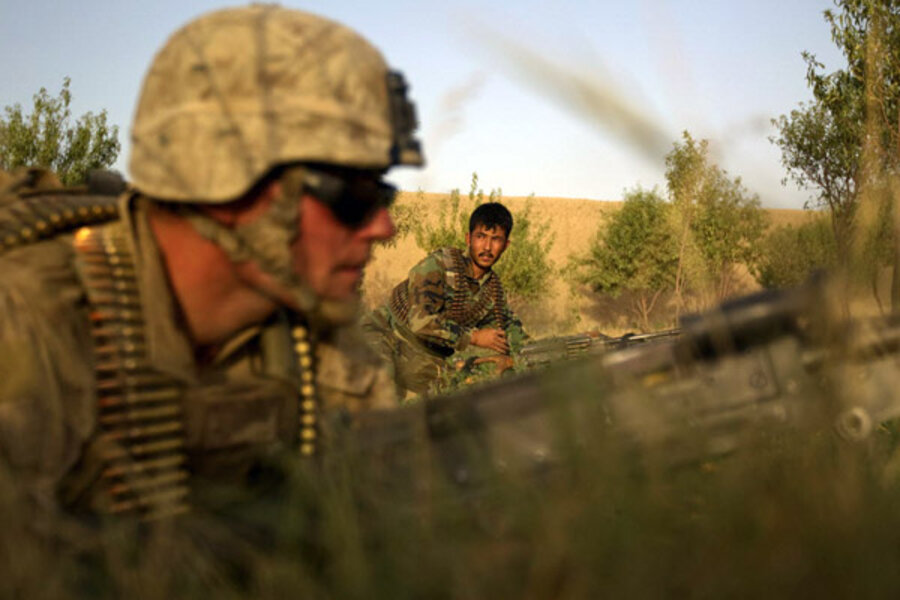In Afghanistan, US military officials say it's now or never
Loading...
| Bagram, Afghanistan
US military officials in Afghanistan warn that it’s now or never to make key advancements against insurgent fighters, with the surge of US forces at its zenith and the summer fighting season in full swing.
Yet Taliban forces in the east appear to be launching offensives of their own, with no intention of giving up easily, US military officials say.
Rates of violence bear testament to that resolve. Attacks by insurgents in the east nearly doubled between March 2010 and March 2011. That’s not unexpected, US military officials say, given the surge. They add that attacks in the month of July appear to be on a downward trajectory.
In the weeks ahead, however, US commanders expect violent clashes between Taliban and US soldiers to continue apace in the east, where insurgents often make use of sanctuaries across the border in Pakistan.
With 10,000 of the 30,000 US surge forces scheduled to return to the United States by year's end – the vast majority of which have been based in southern Afghanistan – there is a sense, too, that the clock is ticking for US commanders here.
“We have more forces [in Afghanistan] right now than we will ever have,” says Col. Clay Hall, commander of the US Air Force’s 455th Expeditionary Operations Group (EOG). “There’s a feeling of, ‘Let’s use them to maximum effect.’ As we pull out,” with fewer and fewer US troops on the ground, “those engagements are going to become less and less effective.”
The US military’s role in Afghanistan was to be a central point of discussion in at least two congressional hearings this week. Gen. Martin Dempsey fielded questions on the way forward in Afghanistan during his Senate confirmation hearing Tuesday for serving as chairman of the Joint Chiefs of Staff. The House Armed Services Committee, on Wednesday, was to hear testimony from former military and defense officials about US activity in Afghanistan. [Editor's note: The original version of this paragraph should have indicated that the House Armed Services Committee hearing was on Wednesday.]
On the ground here, US commanders say they see few signs of violence abating. Military officials point to a hair-raising battle between insurgents and US troops on May 25 in the violent eastern province of Nuristan.
American forces fought for hours after coming to the aid of Afghan security forces to retake a district center in Doab that had been overrun by Taliban fighters. Shortly after some 40 US soldiers arrived, they were surrounded by “about 300 insurgents,” says Lt. Col. Daren Sorenson, deputy 455th EOG commander and an F-15 pilot who was flying overwatch that day.
US troops started taking fire “from all directions.” As pilots spoke with US forces on the ground, “It’s one of those times where you hear in the tone of voice that they don’t know whether they’re going to make it out of there,” Sorenson adds.
The Air Force joint terminal attack controller (JTAC) on the ground was calm at first. “But his voice changed as soon as they began taking fire,” he says. As the F-15 fighter jets scrambled above, “You could see they were in a very, very bad place.”
The US forces were facing nearly 10-to-1 odds, pinned in by fighters on the steep ridges high above them.
Sorenson and his wingman made a low pass through the narrow valley in their F-15s. This is normally enough to encourage enemy fighters to run, he says, but the insurgents seemed unfazed by the show of force. “They just didn’t stop,” he says. “They knew they had our guys pinned down, and they were determined to keep the fight going.”
The US troops were “taking such effective fire” from the Taliban that bullets were whizzing between them and landing at their feet. Rocket-propelled grenades were flying through the air.
Sorenson dropped every bomb he had during the operation – 14 in total. “It’s extremely rare that we find ourselves in a fight where we deploy all of our bombs,” he says. “But that day we dropped everything we had.”
Still, the fighting did not end. “As fast as we could drop one bomb, our JTAC would say, ‘Good hit, next coordinates.’ ”
The fighters had effectively surrounded troops on the ground. “Literally we are dropping a bomb, pushing the afterburner, lining up, and dropping again.”
After dropping his bombs and being replaced by another team of Air Force fighter pilots, Sorenson returned to base and began listening to the battle on the radio.
The fight lasted several hours as Taliban insurgents stopped, regrouped, and returned, he says. But eventually, the fight ended, with no US fatalities and some 200 Taliban killed, according to US military estimates.
“Frankly, if that’s the method they want to use, that’s fine. We very much have the enemy on his heels,” says Maj. Gen. Daniel Allyn, commander of the 1st Cavalry Division and of Regional Command East. “At the end of the day, the insurgents held the district center for 24 hours and lost somewhere in the vicinity of a couple hundred to do it,” he adds. “It’s a Pyrrhic victory is the bottom line.”
Still, it illustrates the intensity of fighting that US troops must wage, says Sorenson: “Our guys got really close to being overrun.”





